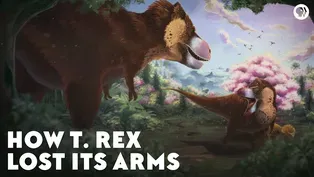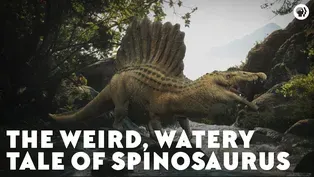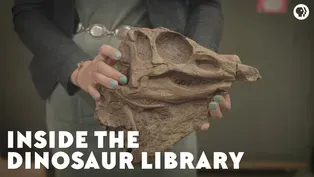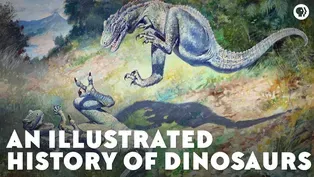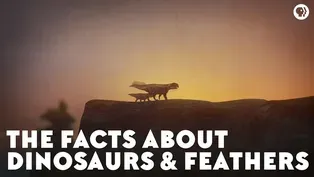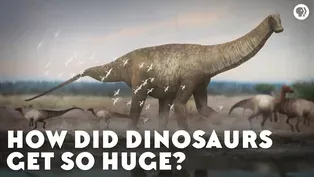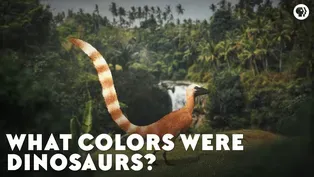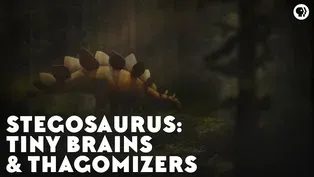
Living Fossils' Aren't Really a Thing
Season 1 Episode 16 | 5m 5sVideo has Closed Captions
Even the most ancient-looking organisms show us that evolution is always at work.
Crocodiles, horseshoe crabs and tuatara are animals that have persisted for millions of years, said to have gone unchanged since the days of the dinosaurs. But even the most ancient-looking organisms show us that evolution is always at work.

Living Fossils' Aren't Really a Thing
Season 1 Episode 16 | 5m 5sVideo has Closed Captions
Crocodiles, horseshoe crabs and tuatara are animals that have persisted for millions of years, said to have gone unchanged since the days of the dinosaurs. But even the most ancient-looking organisms show us that evolution is always at work.
How to Watch Eons
Eons is available to stream on pbs.org and the free PBS App, available on iPhone, Apple TV, Android TV, Android smartphones, Amazon Fire TV, Amazon Fire Tablet, Roku, Samsung Smart TV, and Vizio.

Welcome to Eons!
Join hosts Michelle Barboza-Ramirez, Kallie Moore, and Blake de Pastino as they take you on a journey through the history of life on Earth. From the dawn of life in the Archaean Eon through the Mesozoic Era — the so-called “Age of Dinosaurs” -- right up to the end of the most recent Ice Age.Providing Support for PBS.org
Learn Moreabout PBS online sponsorshipMore from This Collection
Video has Closed Captions
Tyrannosaurus rex had tiny arms. How did this happen, and why did it keep them? (6m 54s)
The Weird, Watery Tale of Spinosaurus
Video has Closed Captions
In 1912, a fossil collector discovered the world’s only known semi-aquatic dinosaur. (7m 28s)
Video has Closed Captions
We talk to Amy Atwater, Collections Manager at the Museum of the Rockies. (7m 19s)
An Illustrated History of Dinosaurs
Video has Closed Captions
Our image of dinosaurs has been constantly changing since naturalists started studying the (12m 20s)
The Facts About Dinosaurs & Feathers
Video has Closed Captions
Dinosaurs have been found with some sort of fluff or even full-on plumage. (10m 1s)
How Did Dinosaurs Get So Huge?
Video has Closed Captions
Creatures as tall as a five-story buildings shook the Earth. (5m 42s)
Video has Closed Captions
We know a lot about dinosaurs but there’s one question that has plagued paleontologists.. (5m 2s)
Stegosaurs: Tiny Brains & Thagomizers
Video has Closed Captions
If you take it as a given that extinct dinosaurs were all weird and wonderful, then you go (4m 49s)
Providing Support for PBS.org
Learn Moreabout PBS online sponsorshipThanks to Curiosity Stream for supporting PBS Digital Studios Crocodiles.
Horseshoe crabs.
And of course ... tuatara!
They're all animals that have persisted for millions of years, said to have gone unchanged since the days of the dinosaurs.
So, like, living fossils.
Right?
Well, no, not really.
When you look at the history of life on Earth, you see lots of major changes.
In one part of the tree of life, you'll find a lineage of lobe-finned fish that gave rise to amphibians.
In another, a branch of feathered dinosaurs evolved into birds.
And a subset of adorable little hoofed mammals even developed into whales.
But there's a whole category of species that apparently didn't get the memo that dramatic change is where it's at.
These are things like your nautiluses, your coelacanths, your ginkgo trees -- organisms that look basically the same today as they do in the fossil record.
People call them "living fossils."
But, at the risk of being "that guy," the idea of a "living fossil" is kind of problematic.
Really, the only guy who can get away with using that term is Charles Darwin, because - - well, he coined it more than 150 years ago.
In 1859, he pointed out that some animals - - like the duck-billed platypus and the lungfish - - seemed to have held onto the same basic body plan for millions of years.
And Darwin figured, that was because there was no evolutionary need for them to change.
It was an important insight.
But since Darwin's day, this rather simple idea has gotten bundled up with a bunch of misconceptions about evolution.
Today, the term "living fossil" is sometimes taken to mean that some organisms evolve, while others don't.
Or that living things only evolve ... some of the time.
But just one of the problems with the idea of "living fossils" is that there are actually many plants and animals that look a lot like their distant ancestors.
If the definition of a living fossil is an organism that's basically unchanged over long periods of time, then we got a whole world of living fossils around us!
For example, jaguars and gray wolves would fit that description, because fossils that look just like them can be found as far back as the last Ice Age.
And ... we'd be living fossils, too!
(Some days, to be honest, I feel like one myself.)
But, the oldest remains of Homo sapiens are more than 200,000 years old, and those fossils look just like us.
So, as a descriptive term, "living fossil" doesn't seem very useful, at least on smaller geologic time scales.
But another, bigger problem with this idea, is that it makes organisms sound like they haven't changed at all, when in fact, they're the results of millions of years of evolutionary pressure.
Just take a look at one of the most famous so-called living fossils -- the crocodylians, like alligators, crocodiles, and gharials.
Today's crocodylians are all aquatic ambush predators.
They stay close to the water's edge and attack whatever prey that comes within range.
And we know from the fossil record that, way back in the Jurassic Period, there were croc-like ancestors -- called crocodylomorphs -- that looked more or less like the crocs we know today.
But look into the even deeper past, and you'll find a staggering array of croc-like reptiles unlike anything we see now!
More than 200 million years ago, in the Late Triassic Period, some of these reptiles lived not at the water's edge but on land.
I'm talking about truly terrifying carnivores like Postosuchus, which basically looked like a four-legged T. rex.
By contrast, in the Late Jurassic, there were others, like Dakosaurus, that spent their lives entirely out at sea.
These reptiles lost their body armor, had feet that looked like flippers, and used shark-like tail fins to move through the water.
So, crocodiles didn't just slide into the water and stay the same since the Triassic.
Sure, you can find a fossil of a croc ancestor that looks more or less like a modern one.
But what you're not seeing are all of the forms of crocodylians that have since been lost -- ones that show us how much their family has changed.
Which brings me to one last point.
And that is: Life is evolving all the time, even if we can't see it!
Just because an organism might look much like it did millions of years ago, that doesn't mean that it hasn't felt the effects of evolution.
Genes, if not anatomy, can show us that life is constantly evolving.
For your consideration, there's the tuatara!
Show me your best tuatara I just got a neck cramp This reptile from New Zealand looks straight-up like a lizard, but it actually belongs to an entirely separate group of reptiles called Rynchocephalians.
These reptiles thrived over 200 million years ago, but the tuatara is the last remaining member of their family.
Because of its ancient pedigree, the tuatara is often called a "living fossil" Oh man I'm a living fossil!
but its DNA proves that it has changed over time -- a lot.
A study in 2008 compared the mitochondrial DNA from both modern and fossil tuatara bones.
And it found that this reptile is undergoing faster genetic change than any other vertebrate.
Its bones may resemble those of its Jurassic relatives, but at the molecular level, the tuatara -- like all of us!
-- is changing all the time.
So, sometimes evolutionary changes are big and obvious, but sometimes they're almost imperceptibly small.
Even the most ancient-looking organism carries a record of its history in its anatomy and its genome, and together they show us that evolution is always at work.
PBS Digital Studios is sponsored by Curiosity Stream, where you can stream documentary films, and programs about science, nature, and history, including exclusive originals!
And if you're watching me right now, you should probably check out Planet Dinosaur, a three-part BBC series about the latest discoveries from the days of the non-avian dinos.
Curiosity Stream offers unlimited streaming, and for you Eons viewers -- because I like your face!
-- the first two months are free if you sign up at curiositystream.com/eons and use the promo code...wait for it...
EONS.
Now what do you want to know about the story of life on Earth?
Let us know in the comments.
And don't forget to go to youtube.com/eons and subscribe!
But the fun doesn't end here!
Do yourself a favor and check out some of our sister channels from PBS Digital Studios.

